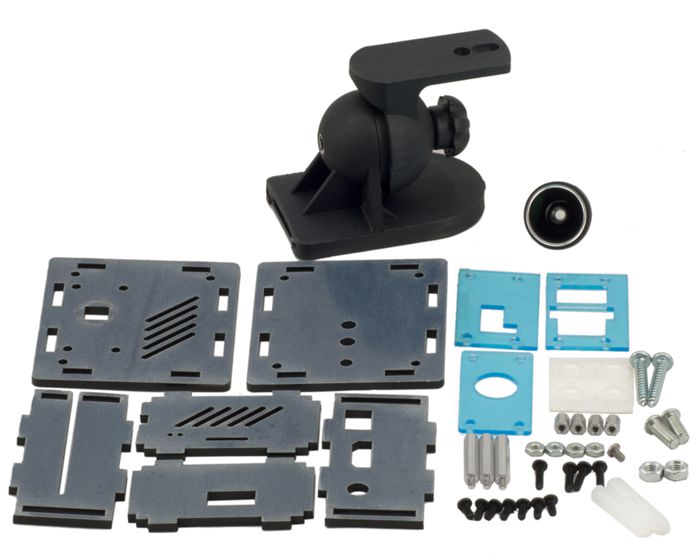
Nwazet Pi A+ Camera Box Assembly Instructions
The laser-cut part of the camera box are protected by an adhesive film which needs to be removed before assembly.
Bill of Materials
- Raspberry Pi model A+
- Raspberry Pi Camera
- 6x black matte acrylic plates
- 3x thin clear acrylic plates
- 7x 1/4" black screws
- 1x 3/16" steel screw
- 4x 7/16" black screws
- 4x hex nuts
- 3x 1" M/F hex standoffs
- 4x 1/4" F/F hex standoffs
- 4x rubber feet
Optional for wall mounting:
- wall mount
- 2x M5 screws
- 2x M5 nuts
Optional:
- magnetic lens
Note: Acrylic is a hard and stiff plastic which is sensitive to stress concentrations and shares a certain level of fragility with glass. Acrylic can scratch easily and should be cleaned with a mild solution of dish detergent and warm water. Never use cleaners unsuitable for acrylic. Never use a dry, abrasive cloth.

Here are all the pieces from the bill of materials, before the acrylic pieces have had their protective paper peeled off.
- Peel off the protective film from both sides of all the acrylic pieces.
-

Orientate the RPi Model A+ so that the Raspberry Pi Logo is upright, then insert a 1” male/female standoff into the top-left, bottom-left and bottom-right mounting holes on the board and secure on the underside of the board with a ¼” standoff.

With the remaining mounting hole, top-right, insert the 3/16” silver screw and secure with a ¼” standoff.

-

If you are not using the optional wall mount, you can skip this part. If you are, locate the two M5 screws and nuts.
Insert the two M5 screws into the two corresponding holes of the bottom of the case and through the wall mount. The heads of the screws should be on the inside of the box

Make sure the wall mount and the bottom plate are properly aligned, then secure the wall mount onto the bottom of the case with the two M5 nuts. -

Now we are going to fix the pi to the bottom plate. With the two wall mounting holes at the top and the USB port of the pi at the bottom, place the pi on the bottom plate and secure from the underside using the ¼” black screws

-

Take the camera ribbon cable and attach one end to the Raspberry Pi’s camera connector, located in between the HDMI port and the 3.5mm jack. Very gently pull up both ends of the top part of the connector. It should make a small clicking sound and should move a little around the connector, leaving enough space to easily insert the camera's ribbon cable. Insert the camera's ribbon cable into the camera connector, making sure the contacts face the HDMI port. Holding the cable to the bottom of the connector, and making sure it remains properly aligned, push the top part of the connector back down. The cable should now be securely attached to the Raspberry Pi.

-

Make sure you have each of the 4 camera box walls in the correct orientation (check image for reference, the edges marked with an arrow should be facing up, opposite side slotting into the bottom plate) and slot them into position around the Raspberry Pi.

-
Now we need to attach our camera modyle to the front plate. Start by placing the thin clear acrylic plate into position and insert a M2 x 10mm screw into each corner mounting hole.

Carefully turn the plate over so the ends of the screws are now facing you. Place TWO M2 washers onto each of the screws.
 Add the camera module and secure in place using the M2 nuts.
Add the camera module and secure in place using the M2 nuts.

- If you are adding a lens - In the little lens box, you will find a magnetic metal ring. Peel off the blue protective film, peel off the self-adhesive backing and stick the metal ring to the front of the case around the camera lens. Be sure to press it on nice an firm so you get a good fit.

- Now simply place the lens onto the magnetic ring!



















